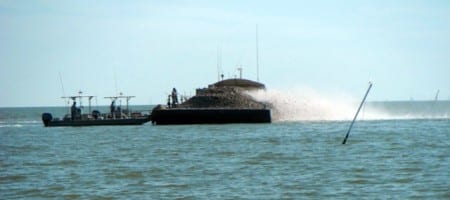 By Lady Redfish
By Lady Redfish
Have you ever wondered how our reefs in East Bay are replenished to continue producing those marvelous oysters? My husband has seen this process before, but I saw it for the first time this past Friday on a reef fairly close to the north shoreline. Two crew boats arrived to the reef first with a barge in the distant background. The barge contained a large load of material which appeared to be oyster shell or some type of rock. The two crew boats tamped the bottom of the bay along the reef with long poles. Once they had determined a spot they led the barge to the area. The two crew boats positioned their bows on the back side of the barge to stabilize the vessel. A large hose similar to a fire hose was used to blow water onto the material and into the bay below.
According to the Texas Parks & Wildlife Department website, growth of oysters in Texas waters is relatively fast and occurs throughout the year. Under ideal conditions, a young oyster may reach one inch in three months, two inches in seven months, and three inches in 15 months. Nevertheless, growth can be variable and oysters of identical age may differ markedly in size. Probably most Texas oysters reach the legal market size of three inches in 18 to 20 months.

In addition to benefiting the commercial oyster industry, our East Bay reefs provide ecological benefits. One of the primary ecological functions of oyster reefs is water filtration. Oysters feed by filtering tiny plants from the water and a single oyster can filter up to 50 gallons of water in a day. This filter feeding also removes silt and some contaminants from the water. Oyster reefs also provide habitat for numerous bottom-dwelling fish and invertebrates, which are in turn food for larger game fish making our reefs popular spots for the recreational fishermen.
Oysters are not only delicious, but they are an are an excellent source of vitamins A, B1(thiamin), B2 (riboflavin), B3 (niacin), C (ascorbic acid) and D (calciferol). Four or five medium size oysters supply the recommended daily allowance of iron, copper, iodine, magnesium, calcium, zinc, manganese and phosphorus. However the FDA warns that people with underlying health conditions such as liver disease, cancer, diabetes, and immune disorders should never eat raw oysters.

 Posted in
Posted in 
























Good story never seen it myself and I am out there all the time thanks
Wrong, Cynthia.
High salinity levels caused by the influx of salt water through Rollover into East Bay has adversely affected oyster reproduction. Ask Ben Nelson, oysterman from Smith Point.
One thing about these oyster beds is their fragile level of a mix of fresh and salt water. By closing the Pass, this mix is in danger which makes the oyster beds likely to die out! Many more things to consider when closing Rollover Pass!